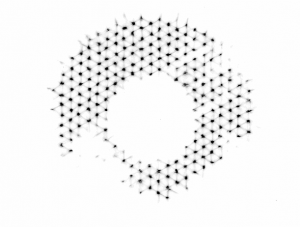Despite nearly a month of heavy smoke, fog, rain and hail we have completed our tests with the Deployable Wave Front Sensors (DWFS) on the Focal Plane Assembly (FPA). In these tests we were putting geostationary satellites on the various DWFS units across the FPA. While the final report on the image quality of the Corrector optics are still pending we do know that the image quality is good enough to move on to the next stage of commissioning. We will likely leave the central DWFS unit in place to allow us to check and re-optimize the image quality as we make further changes to the mount model. Below is an image of what a single bright star looks like through the DWFS unit. You can see that the light is broken up into small sub-aperatures (not each mirror) and then the distribution of those spots, ie. how evenly they are spaced, can tell you about the deformations of the optical system. The Corrector is the area in the center without the spots. The tracker rails run from 2 o’clock to 8 o’clock where the lower X work platform is still installed.
On the staffing side of operations the good news is that we are fully staffed. We have a new electrical engineer and a optical technician starting this past week and a telescope operator joined us the week before. The bad news is that one of our other telescope operators has decided to retire as of the 14th of this month. We will be posting the position in the coming week.
The mirror team has begun an intensive inspection and repair regiment for the primary mirror actuators and electronics. They have found a number of damaged connectors and replacement of these connectors seems to have improved reliability considerably.
We have successfully tested the cooling of the first VIRUS enclosure. The cooling is accomplished by bringing in glycol that is only slightly cooler than the dome ambient temperature and then additional cooling from a small thermo-electric cooler is added when needed. This test was accomplished with no VIRUS units installed but artificial heat loads induced. We will have to wait to see how the system performs under the full load of the VIRUS units.

